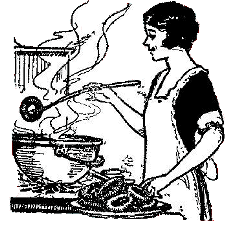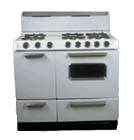












































































|
 |
THE 1930'S KITCHEN
 The 1930s—Art Deco was in full force, William Powell and Myrna Loy made the delightful Thin Man movies, Hollywood stars and sleek roadsters were all the rage, little girls solved mysteries with Nancy Drew—and great times had finally come for the well-to-do homemaker or servant in a wealthy household. Gone was the empty room at the back of the house with a hole through the wall (or the window) for the stove chimney and a pump outside the door. The age of truly labor-saving devices and scientifically designed kitchens had arrived. At her beck and call the kitchen worker had an electric refrigerator, electric or gas stoves, toasters, waffle irons, percolators, and, of great boon for storage, pre-made, built-in kitchen cabinets both top and bottom, with counter space for food preparation.1 The well-scrubbed wooden floor was replaced by one covered with easy-to-mop linoleum. One efficient kitchen was even developed by motion-study expert Lillian Moller Gilbreth, of Cheaper by the Dozen fame, anticipating the modern kitchen with a wheeled "preparation cart" that could be use to save housekeeper and cook many steps. By the late 1930s, electric grills were being sold for homes and chafing dishes were all the rage. The 1930s—Art Deco was in full force, William Powell and Myrna Loy made the delightful Thin Man movies, Hollywood stars and sleek roadsters were all the rage, little girls solved mysteries with Nancy Drew—and great times had finally come for the well-to-do homemaker or servant in a wealthy household. Gone was the empty room at the back of the house with a hole through the wall (or the window) for the stove chimney and a pump outside the door. The age of truly labor-saving devices and scientifically designed kitchens had arrived. At her beck and call the kitchen worker had an electric refrigerator, electric or gas stoves, toasters, waffle irons, percolators, and, of great boon for storage, pre-made, built-in kitchen cabinets both top and bottom, with counter space for food preparation.1 The well-scrubbed wooden floor was replaced by one covered with easy-to-mop linoleum. One efficient kitchen was even developed by motion-study expert Lillian Moller Gilbreth, of Cheaper by the Dozen fame, anticipating the modern kitchen with a wheeled "preparation cart" that could be use to save housekeeper and cook many steps. By the late 1930s, electric grills were being sold for homes and chafing dishes were all the rage.
 Of course the operative word here was "well-to-do" or wealthy. There was a little event called the Great Depression taking place, and, although by 1939, most people had emerged from the penny-pinching ways of the early part of the decade, there were still thousands of inner-city dwellers and rural families—rural families still outnumbered the urban dwellers of the American population2—who were still "making do" with "grandma's kitchen," some because they couldn't afford anything newer, some simply because women were more comfortable working with what they had grown up with—like Gran Preston in Kate Seredy's The Open Gate, they preferred "a stove that took orders from the cook instead of the other way around." For every woman who had a spiffy new kitchen with built-in cabinets—by the 1940s metal cabinets were very trendy—and a modern-styled, smokeless electric kitchen range (as pictured at the opening to this paragraph) and electric refrigerator with the motor on top, many more still worked in what we today might call a very Victorian kitchen: the enameled or even blackened wood stove with its hot water reservoir and warming shelf, a freestanding sink (pipes discreetly covered with gingham cloth) with either x-handled faucets or perhaps even an old pump, an icebox with the perpetually overflowing tray underneath, storage in the form of a shelved alcove or freestanding cupboard, a "Welsh dresser" or hutch for dishes, and the table or perhaps a well-loved wooden or enameled "Hoosier" cabinet3 for baking and preparation of other foods. Some of these kitchens were still lighted with gas or kerosene. Indeed, farm families lived this way well through the forties; when rural electrification came to their area, they typically wired the barn and other work buildings first, like the Preston/Van Keuran families (The Open Gate)—it was installed where it could save the most work. All the Remember WENN characters would have grown up with this type of kitchen, and certainly some of them might still have one, or have relatives that had one. Of course the operative word here was "well-to-do" or wealthy. There was a little event called the Great Depression taking place, and, although by 1939, most people had emerged from the penny-pinching ways of the early part of the decade, there were still thousands of inner-city dwellers and rural families—rural families still outnumbered the urban dwellers of the American population2—who were still "making do" with "grandma's kitchen," some because they couldn't afford anything newer, some simply because women were more comfortable working with what they had grown up with—like Gran Preston in Kate Seredy's The Open Gate, they preferred "a stove that took orders from the cook instead of the other way around." For every woman who had a spiffy new kitchen with built-in cabinets—by the 1940s metal cabinets were very trendy—and a modern-styled, smokeless electric kitchen range (as pictured at the opening to this paragraph) and electric refrigerator with the motor on top, many more still worked in what we today might call a very Victorian kitchen: the enameled or even blackened wood stove with its hot water reservoir and warming shelf, a freestanding sink (pipes discreetly covered with gingham cloth) with either x-handled faucets or perhaps even an old pump, an icebox with the perpetually overflowing tray underneath, storage in the form of a shelved alcove or freestanding cupboard, a "Welsh dresser" or hutch for dishes, and the table or perhaps a well-loved wooden or enameled "Hoosier" cabinet3 for baking and preparation of other foods. Some of these kitchens were still lighted with gas or kerosene. Indeed, farm families lived this way well through the forties; when rural electrification came to their area, they typically wired the barn and other work buildings first, like the Preston/Van Keuran families (The Open Gate)—it was installed where it could save the most work. All the Remember WENN characters would have grown up with this type of kitchen, and certainly some of them might still have one, or have relatives that had one.
Thriving restaurants received the newest in industrial kitchen appliances as well, but the majority of the smaller family-owned establishments continued on as they had, with Mom's old range turning out breakfast biscuits and broiled steak with equal aplomb. What a thrill it must have been when the profits afforded buying a new appliance! The 1930s were also the heyday of the diners, designed on the lines of the new streamlined trains and featuring a language all their own.4
Because shipping methods weren't as advanced in that era, fruits and vegetables had definite seasons. Today we see all sorts of items all year long, shipped from around the world; back then stores stocked what was actually growing at that time of year. If you wanted fruits in the winter you canned or dried them in the fall. Salads were eaten in the spring and summer, squashes, turnips, and other "hardy vegetables" in the fall and winter. "Exotic tropical fruits" such as oranges and grapefruit were expensive when they were even available in the winter months—people who are surprised at old children's Christmas stories that make such a fuss about receiving oranges and nuts for holiday treats must remember these were costly and rare items in December for those people on limited budgets. People in very rural areas might see an orange only that one time a year.5
Today chickens and turkeys are so widely raised that poultry is generally the "cheap eat" in the supermarket. Back in the 1930s chicken was a treat: the term "chicken every Sunday" meant you were fairly well off and the campaign slogan "a chicken in every pot" spoke of prosperity. Diana Barry in Anne of Green Gables speaks of richness being able to eat chicken salad at every meal. If you had a chicken for dinner it was usually an older, tough bird that was no longer profitable and only fit for chicken and dumplings, or the roosters in the flock—hens of laying age were too valuable to sell for meat. Pork was the cheap meat back then, as well as inexpensive cuts or ends of beef that could be stewed to tenderness or roasted, and "organ meats" such as kidneys and liver. In the South ham, smoked or sugar-cured, was the meat of choice. Turkey and goose were for holidays and for a city family, might take all year to save up for one. During the Depression, anyone with a rifle, city or country dweller, might supplant their meat supply with squirrel, rabbit, pheasant, dove (pigeon), and quail, not to mention venison. Then came rationing during World War II and these alternative meats were still in demand, along with poultry, which was not rationed.
1 A man clever at cabinetry might make his wife some built-in units, or trade some sort of labor or goods for their purchase. Laura Ingalls Wilder, for instance, had ingenious built-in bins in her Missouri kitchen, but she designed them herself according to her needs and her husband built them. They were not available "prebuilt" (like the stock units one can get today from building supply stores) from homebuilders until the 1930s.
2 1930 Federal Census
Urban population= 744,273
Rural population= 1,901,975
1940 Federal Census
Urban population= 855,941
Rural population= 1,977,020
3 These Hoosier cabinets were extremely popular up until the advent of built-in cabinetry and so called because most of them were manufactured in Indiana. At the peak of their popularity, one factory was churning them out at 600 a day. Some contained flour bins that held up to 50 pounds of flour, spice racks, and sugar dispensers, and might have bread boxes or potato bins below.
Hoosier Cabinets
http://www.suite101.com/article.cfm/antiques_and_collectibles/68444
4 List of Diner Slang
http://www.allbaking.net/ch/2000/may/dinerdesserts.html
5 Typically fresh foods were pretty much only stored for the day, iceboxes not being that efficient. In farm and rural families the perishables came straight from the barn or field; in the cities women were accustomed to going to the market every day. Lucky farm families might have a spring house (a shed/outbuilding where the milk, cream, and butter was kept that had cold spring water to keep the items cool) or a root cellar to preserve things as well.
|




![]()